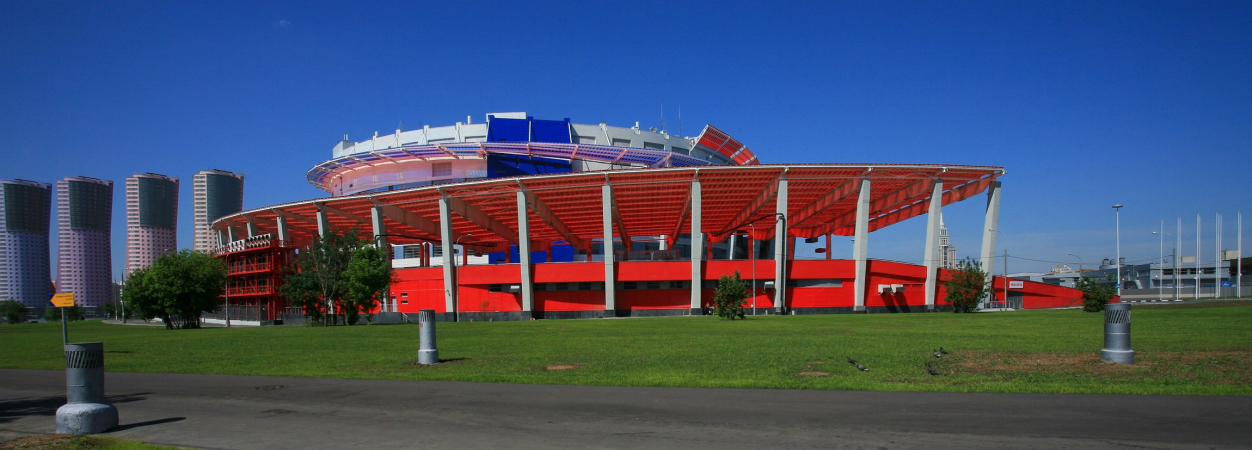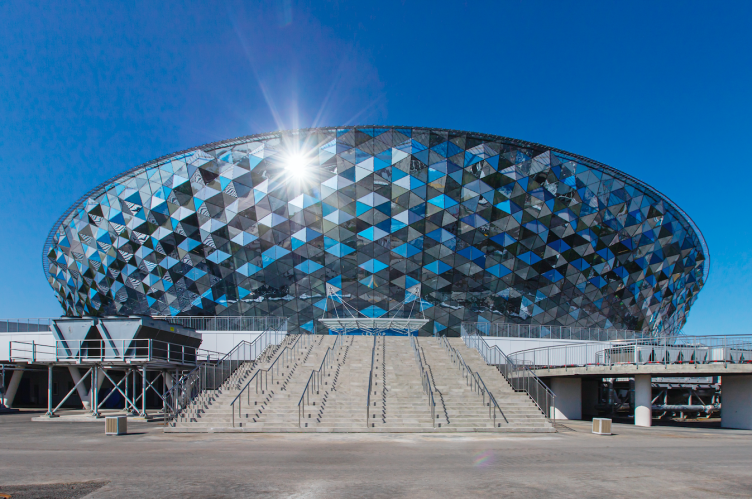An ice arena is a complex object that has to meet a multitude of requirements that are posed by federations of various sports, television that broadcasts live, as well by the regular fire safety agencies and other institutions. On top of it all, there is a specific task of ensuring high-quality ice in any season, which adds to the project a cooling plate with refrigerators, a whole complex of ventilation measures, units for water treatment and premises for ice filling machines.
Since ice arenas are designed for practice sessions and competitions in hockey, sledge hockey, short track, figure skating, and curling, you need to include team locker rooms, rooms for drying tracksuits and sharpening skates, doping control facilities, rooms for the judging panels, as well as press and support teams. You also need to provide the spectators with sound and lighting systems that will ensure excellent performance regardless of the sector the ticket was bought for.
(No, we’re not finished yet!) Further on, such a grand-scale building cannot be single-functional – it must become a public center that includes sports clubs for children, fitness centers, cafes, exhibition spaces, and even offices. This makes the logistics component even more complicated because you need to separate not just the fan sectors, but also the athletes, spectators, press, service personnel, and, ultimately, boys and girls. Not the least issue is the profitability of a sports facility, which is often ensured by its ability to quickly transform into a concert venue.
We suggest checking out how the architects managed to link all these points in one object, while giving it a memorable look.
Designing large sports facilities is a traditional specialization of the Arena Design Institute, which dates back to Mosproject-4, from which we are descendants. The selection presented today reflects an individual approach to the design of such facilities, because, as a rule, they become the “visiting card” of the region. Also, arranged in chronological order, the constructions and current projects clearly show the trend of the last decades of transformation of ice arenas from exclusively professional mono-objects to publicly accessible multifunctional complexes.
Megasport Ice Palace
Architect
Studio
Mosproekt-4
Author collective
architects: Bokov A., Bush D., Chuklov S., Valuiskih V., Romanova L., Gak O., Burchuladze Z., Zolotova A., Timohov A.; architect-technologist: Shabaidash A.; engineers: Livshin M., Kelman M., Eremeev P., Bekmuhamedov E., Starikov O., Naumocheva A., Subbotina E., Starikova N.
Where
Russia, Moscow
Date
2004 — / — 2006
Function
Sport / Sports complex
The arena has a capacity for 14,000 spectators; it was built for the World Hockey Championship 2006, when the territory around the Khodynskoe Field started taking the mottled and pretty sci-fi look the way we know it today. Even today, “Megasport” successfully holds its own against a whole galaxy of high-profile projects: towers, shopping malls, grand-scale housing complexes, and cathedrals. The arena is shaped somewhat like a spinning propeller – as Grigory Revzin notes, this is homage to the former airfield, upon which this ice arena has been built. In the center of the composition, there is a white cylindrical volume with a diameter of 120 meters and a height of almost 50 meters, with a purposefully sagging membrane of the roof. The cylinder belts the spirals of the ramps with awnings: the red ramp leads to the spectator seats of the red sector; the blue one predictably to the blue. As you go higher up, the width of the ramp shrinks from 30 meters to five, making the flow of spectators thinner. Thanks to the heating system, ice does not form on the ramps in the wintertime. The arena hosts more than 100 events a year: both sports ones, including boxing matches and gymnastics competitions, and concerts. Also, a few movie scenes were shot inside the arena.
“Iceberg” Palace of Winter Sports
Architect
Studio
Where
Russia, Adler
Date
2009 — / — 2013
Function
Sport / Sports complex
The arena’s capacity is 12,000 spectators; it was built for the Olympics 2014. This is Sochi’s only indoor skating rink that allows you to conduct practice sessions, mass skating events, and figure skating / short track competitions all year round. Ice is another aggregate state of water, so in a southern city it seemed appropriate to interpret a wave on the facade, referring to the proximity of the Black Sea and echoing the silhouettes of the mountains. In the lower part of the building, the volumetric facade is raised, revealing the stained glass windows of the foyer and main entrances. The cladding uses transparent and colored glass of several shades of blue, which overlap each other like tiles, creating visions of ripples, sun glares on the water, or foam on the waves. In total, more than 600 tons of double-glazed windows are used on the facades of the Iceberg. Inside, the color helps spectators navigate between tiers and sectors. The problem of post-Olympic use was solved in a revolutionary way: the prefabricated type of construction allows the building to be dismantled and then moved to another city. This, however, was never required.
Ссылки
The multifunctional ice complex “Humo Arena”
Studio
Where
Uzbekistan, Tashkent
Date
2017 — / — 2019
Function
Sport / Ice Arena
The arena’s capacity is 12,500 people. It is situated in the central part of Tashkent, and is the biggest ice palace in Central Asia, and a home of four hockey clubs. The concept was developed by the Korean company Heerim Architects. The arena is named in honor of the mythical bird Humo, the harbinger of happiness. The main volume of the building resembles the folded wing of the bird, while the fan of the buildings, ramps and paths of the adjacent park resembles the flapping and spreading feathers of the bird. The halls lined with dark marble are decorated with round panels created by artists Bobur Ismailov based on the poem “The Language of Birds” by Turkic poet Alisher Navoi. The central piece is a golden composition with a stone that was laid when the complex was built. The arena can host more than a dozen sports, but its “specialty” is still hockey. The cooled slab allows to place a hockey court of three different sizes depending on the requirements of different hockey federations, and the main arena is supplemented by a training arena.
The multifunctional ice arena in Novosibirsk
Architect
Studio
Arena Projwect Institute
Where
Russia, Novosibirsk
Date
2018 — 2019 / 2021 —
Function
Sport / Ice Arena
The arena’s capacity is 12,500 people. It is situated in the central part of Tashkent, and is the biggest ice palace in Central Asia, and a home of four hockey clubs. The concept was developed by the Korean company Heerim Architects. The arena is named in honor of the mythical bird Humo, the harbinger of happiness. The main volume of the building resembles the folded wing of the bird, while the fan of the buildings, ramps and paths of the adjacent park resembles the flapping and spreading feathers of the bird. The halls lined with dark marble are decorated with round panels created by artists Bobur Ismailov based on the poem “The Language of Birds” by Turkic poet Alisher Navoi. The central piece is a golden composition with a stone that was laid when the complex was built. The arena can host more than a dozen sports, but its “specialty” is still hockey. The cooled slab allows to place a hockey court of three different sizes depending on the requirements of different hockey federations, and the main arena is supplemented by a training arena.
The ice palace on the territory of the Spit of Nizhny Novgorod
Architect
Studio
Where
Russia, Nizhny Novgorod
Date
2018 — /
Function
Sport / Ice Arena
The arena’s capacity is 12,500 spectators. It will complement the architectural ensemble of the Spit of Nizhny Novgorod, which already includes a soccer stadium, restored warehouses, and the Alexander Nevsky Cathedral. In order to minimize its contrastive influence on the latter, the arena was moved as much as possible towards the Samarkandskaya Street, its height from the city towards the water lowering from 38 to 14.5 meters. The streamlined “pebble” shape and the very position of the building allowed the architects to avoid obscuring the views of the cathedral from the water. The arena faces the city with a media façade and an entrance gallery with an amphitheater on the upper level. The arena is separated from the cathedral by a multi-level landscape composition, in which a cascade of stairs to the second tier is hidden. The area on the shore side will be landscaped and filled with outdoor sports fields. With the help of the stairs, landscaping, gallery and other elements, the “sprawl” of a rather large-scale building is overcome and its integration into the context is achieved. The arena will be the home arena for the Torpedo club, while the lower part of the arena will house a training arena, a four-lane curling hall and two more multipurpose halls. The construction is planned to be completed in 2025.
The Crystal Ice Palace
Architect
Studio
Where
Russia, Moscow
Date
2015 / 2020 —
Function
Sport / Ice Arena
Capacity: 500 people. The arena will be situated on the territory of Luzhniki complex, instead of the skating rink, built back in the 1960s and now recognized to be in an emergency state. The building maintains not just the “posture” of its predecessor, but also the style characteristic for sports facilities of the mid-20th century. It is rather unusual for its typology: it has a rectangular plan, and the glass facades fill the halls with natural light. The ice is protected from direct sunlight by vertical metal lamellae, which like blinds can completely cover the stained glass windows. The main entrance is accented with a stained glass crystal structure. Inside there are two ice arenas with separate entrances for 250 seats each; a 25-meter swimming pool with a view of the park; office premises with windows overlooking the Moskva River; gyms and cafes. A parking lot for 130 cars is located in the underground level.
Gasprom Arena
Architect
Studio
Where
Russia, Yuzhno-Sakhalinsk
Date
— 2022 /
Function
Sport / Ice Arena
The arena in fact includes two ice arenas: one is designed for competitions and has a capacity of 5,500 people, while the second is a training arena with a game and gymnasium and a shooting range. This will allow training and competitions of international level in hockey and other sports, including sport shooting. But the main purpose of the arena is to provide the city’s children with affordable sports clubs. The unified surface of the folded metal roof, passing into the facade, “envelops” the internal structure of the sports facility, manifesting its multifunctionality in the silhouette and opening up with a colonnade at the main entrance. The arena is planned to be built in the center of Yuzhno-Sakhalinsk, on the site of the bus park, which will be relocated to another place. The adjacent territory will be landscaped: landscaping, pedestrian and bicycle paths will be laid and parking for 183 cars will be organized. The construction is planned to be completed by 2025.

























































































